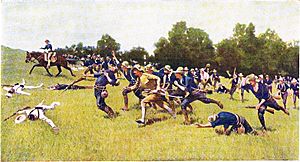Second Eastern Campaign facts for kids
Quick facts for kids Second Eastern Campaign |
|||||||
|---|---|---|---|---|---|---|---|
| Part of Cuban War of Independence | |||||||
 The Rough Riders charging at the Battle of San Juan Hill |
|||||||
|
|||||||
| Belligerents | |||||||
| Commanders and leaders | |||||||
| Strength | |||||||
| 35,000 infantry | 7,800 infantry | ||||||
| Casualties and losses | |||||||
| 624 killed | 2,365 killed | ||||||
The Second Eastern Campaign was a short but very important military operation in Oriente Province, Cuba. It happened from August 1 to 12, 1898, during the Cuban War of Independence. This campaign marked the end of Spanish rule in Cuba and the end of the Spanish Empire in Latin America.
Contents
Background to the War
In the 1890s, Cubans living outside their home country, especially in the United States, started to gather around José Martí. He was a key leader who wanted Cuba to be free. On April 10, 1892, the Cuban Revolutionary Party was created. This party brought together all people who wanted Cuba to be completely independent. They also wanted to help Puerto Rico gain its freedom.
Martí was the main leader of this party. He chose Generals Máximo Gómez and Antonio Maceo to lead the future war for Cuban independence. This war was being planned in 1893.
Starting the Fight
By late 1894, everything seemed ready to start the new war, both inside and outside Cuba. However, a plan called the Plan de la Fernandina failed. This was a big problem for the Cuban independence fighters.
Despite this setback, they decided to start the war on February 24, 1895. This day was chosen because it was a carnival and festival day. The rebels hoped to surprise the Spanish rulers and make it easier to start the fight. Some planned uprisings did not work, and some important leaders were captured or died.
War Continues
Even with these problems, the war went on. Uprisings in Oriente and Las Villas provinces were successful. But the war truly gained strength in April when the Maceo Brothers, Martí, and Gómez arrived in Cuba.
After many challenges, these leaders took command of the Mambisa troops. More and more soldiers joined the fight every day. Many were experienced fighters, and new people also joined.
This led to the First Eastern Campaign starting in early May 1895. The Circular Campaign began in June of the same year. Lieutenant General Antonio Maceo led the first campaign, and Generalissimo Máximo Gómez led the second. Cuban forces won these battles. Then, the Invasion from East to West in Cuba happened between October 1895 and January 1896. This was also a victory for the Cubans.
A Major Loss
Sadly, Major General Antonio Maceo was killed on December 7, 1896, during the Battle of San Pedro. His death was a big blow to the Cuban forces.
Major General Máximo Gómez, the main Cuban commander, chose Major General Calixto García to take Maceo's place. General Calixto immediately worked to make the war stronger in his home province of Oriente. This effort began what became known as the Second Eastern Campaign.
The Campaign's Battles
The Second Eastern Campaign included several important battles. These were:
- Guáimaro in September 1896.
- Cascorro from September to November 1896.
- Jiguaní and Baire, both in March 1897.
- The Capture of Las Tunas in August 1897.
- The Battle of Guisa in November 1897.
When the United States joined the war in June 1898, General Calixto focused on helping American troops land in eastern Cuba. He also helped in the battles of El Caney and San Juan Hill. The war ended in August 1898, and so did the Second Eastern Campaign.
The actions in Oriente Province provided many war supplies for the Cubans. They also showed how strong the Cuban Liberation Army was, even after two and a half years of fighting. The campaign was a victory for the Cubans and helped bring the war to an end.
What Happened Next
The success of this important military campaign made the war in Eastern Cuba even more intense. It also showed that the Cuban forces were active and skilled in fighting. This helped to counter Spanish news reports that claimed the Cubans were defeated and about to give up.
The Cuban forces won important military victories. Many new recruits joined the Cuban Liberation Army. They also got new weapons and ammunition.
While this campaign was happening, General Gómez also led the La Reforma Campaign. In late 1897, during both campaigns, the Assembly of La Yaya took place. Here, the Cuban government in arms was reorganized. Major General Bartolomé Masó was chosen as president, replacing Salvador Cisneros Betancourt. This had been planned before the war started.
After both campaigns ended successfully, the war and Spanish control over Cuba finally came to an end.
See also
 In Spanish: Segunda campaña oriental para niños
In Spanish: Segunda campaña oriental para niños

